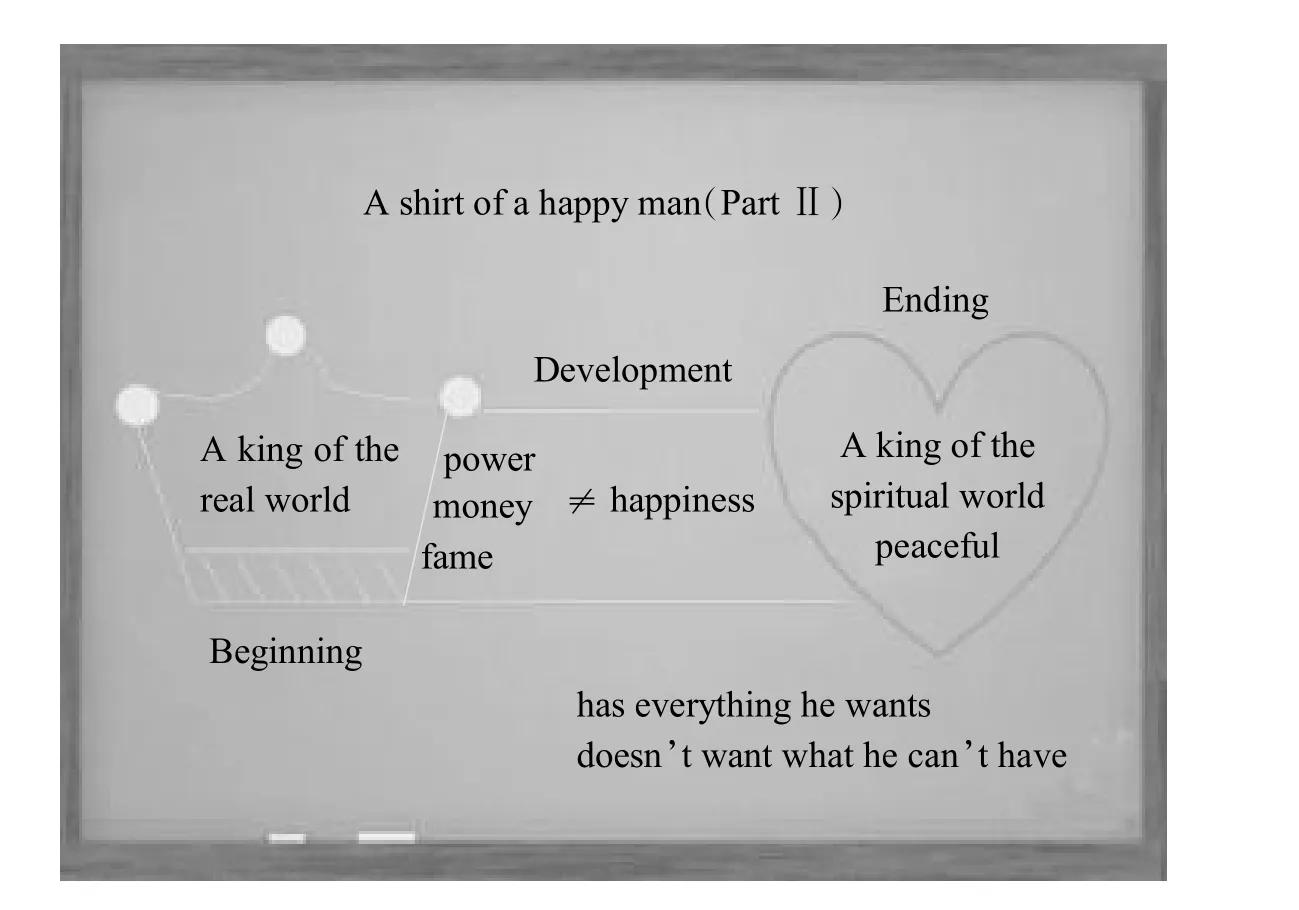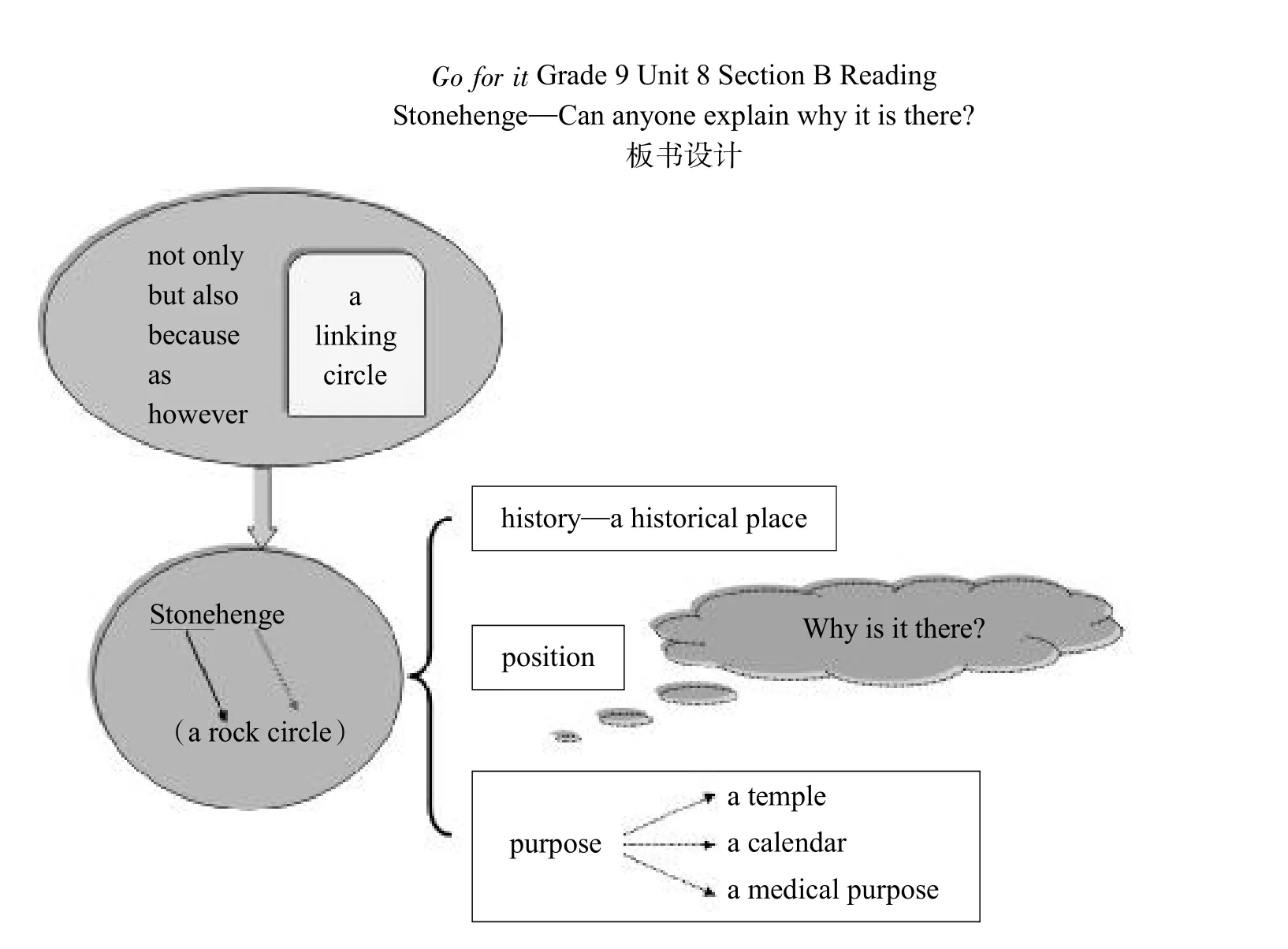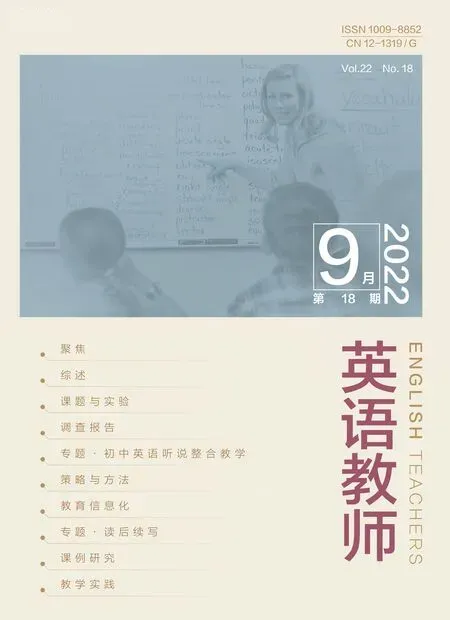通过模拟上课凸显英语学科核心素养的提升点
何 娟
引言
模拟上课的信息传递路径是“授课教师—虚拟中的学生—评委”,是一种一人演绎、多项传递的教学活动。模拟上课是教师综合素质和实践能力的叠加,反映出他们的文本解读能力、教学预测能力与课堂驾驭能力。模拟上课浓缩了传统的说课和授课形式,虽然教师眼前没有学生,但心中要有学生,循循善诱、有效示范、声情并茂,俨然走进真实课堂。
在模拟上课过程中,当虚拟的教学对象从客观实体中抽象出来,如何使教师展示的教学活动折射学科本质,凸显核心素养提升点?
基于对新目标初中英语教材模拟上课课例的观察,下面从四个方面对以上问题加以阐释。
一、基于学生立场,提升思考力
模拟上课虽然面对的是虚拟的学生,但教师仍应站在学生立场,让课堂教学成为自己、虚拟学生和社会的联结。
站在学生的起点立场。学生的“最近发展区”应是教师教育教学的出发点和确立教学目标的依据。
站在学生的主体立场。学生是课堂的主体,模拟上课不能仅仅呈现教学内容,还要关注虚拟学生思维认知的逐级上升。
关注学生立场,离不开适切的问题设置。教师设计合理的输出型问题,有助于学生更自然地对语言知识融会贯通,进行深入加工和综合运用(叶秀秀 2020)。
在提问时,教师的目光应注视虚拟学生,并用手势示意他们回答。只有问题的设置符合指向高阶思维的设问原则,学生的思维才能在广度和深度上得到拓展。教师可灵活、科学地运用参阅型和评估型问题,引导学生的思维向高阶发展。高阶思维设问应具有层次性。展示型问题构成根基,参阅型问题置于中部,评估型问题位于顶端(林燕 2020)。
课例一
新目标初中《英语》九年级Unit 5 What are the shirts made of?Section A(3a—3c)
【文本简介】该文本讲述了一个中学生在美国的商店中找不到美国制造的产品,几乎都是中国制造的事实。同时,文章结尾点明对中国制造高科技产品的期待。
导入及呈现模拟:问题基于学生认知的起点
P=Paraphrase BD=Blackboard Display
Q:If you go to another country,what will you do?
P:Mike says he will go to a shop and buy something.Maybe the products in the local shops attract him a lot.
BD:local,product
Q:If you go to France/Switzerland/Japan/the US,what products will you buy?
P:From your answers,I get to know you’re interested in high-technology products like mobile phones.Are the high-technology products all made in those countries?
BD:mobile,high-technology
【评析】通过第一个问题引导出本堂课重要的生词,扫除阅读障碍。接着,在提出第二个问题时复现之前引出的单词。最后,教师通过“Are these high-technology products all made in those countries?”顺利地过渡到阅读材料。问题的起点符合学生的最初认知。
读前模拟:问题基于标题及图片
T:Predict according to the title and the picture.
1.Where did the boy go?
2.Is it easy to buy local products?Why?
3.What’s the main idea of this passage?
【评析】借助阅读材料的标题、课文插图、循序渐进的问题,逐步引导虚拟学生预测文本,激发其阅读兴趣。
读中模拟:问题基于学生思维的提升
1.Read and answer five questions about“Kang Jian”.
(1)Who is Kang Jian?
(2)When and where did he visit his aunt and uncle?
(3)What did he want to buy?
(4)How many kinds of things made in China did he find?
(5)How does he feel about“Made in China”?
【评析】以上问题有如下特点:
第一,能围绕重难点内容,表述具体、简洁。问题之间有内在的梯度与衔接。
第二,难度适中,落在学生的“最近发展区”,能激发其兴趣,引发其积极参与。
第三,能引发学生的认知冲突,促进其高阶思维的发展。
2.Check the answers and finish the mind map on the blackboard.
【评析】面对虚拟学生,要考虑他们的需要,依托内容学习语言,再依托语言发展思维,而思维的发展有助于内容的有序组织。因此,在建构语言知识结构时,考虑将文本的结构、内容和语言融合在一起,使语言形式结构化(叶咏梅 2020)。这可以用思维导图(见图1)建构。在解决问题的过程中穿插思维导图的辅助梳理,逻辑清晰、内容直观,有利于语言表达。教师引导学生寻找五个关键信息,既训练其寻找信息的能力,又对文本信息进行整理和再建构。同时在核对答案时,模拟学生完成思维导图,体现思维能力的培养。

图1
读后模拟:问题基于学生思维的创新
Q&BD:What does“Made in China”mean?
T:Think and fill in the blanks.(见图2)

图2
模拟学生展示:We should move from“Made in China”to“Created in China”,from“China speed(速度)”to“China quality”and from“Chinese products”to“Chinese brands”.
T:It’s your job to make it come true.
【评析】经过阅读和填空,学生对“中国制造”的了解已趋于全面。因此,这个问题不仅是对“中国制造”字面意思的解释,还是对“中国制造”产品的评价。作为一名中国学生,在为国家感到自豪的同时,还应发现需要提升之处,从而产生强烈的使命感——要为中国的进一步强大贡献自己的力量!同时,“What does‘Made in China’mean?”这一问题及其拓展的填空可检测学生能否运用所学,提炼并创新表达自己的观点,体现对其可持续性评价。教师的点评不能只指向问题的正确答案,还应具有启发性和延续思考性。最后,教师要让学生离开起点,促进其思维的发展与提升。
二、基于教师话语,提升语言味
教师话语是阐述教学内容使学生理解的必要手段。它促进学生的思维,激励他们的情感与意志,给予其情绪性影响(钟启泉 2017)。模拟上课要避免偏重教师个人角色的表现和个人表演。模拟上课是教师单口,却要分饰多角,演绎成群口。它要求教师尽可能模拟学生应答或反射,体现预设中的合理生成,在教师多重角色的语言展示中体现文本解读能力、示范能力、教学牵引力等。此外,肢体语言、语言的美感、声音的抑扬顿挫等可以起到有效的辅助作用。
课例二
新目标初中《英语》九年级Unit 11 Sad movies make me cry Section B(1a—1e)
【文本简介】该听力语篇是戏剧The shirt of a happy man的第二部分。教师引领虚拟学生猜测将军能否找到感受幸福之人,讨论那位穷人为什么感到幸福及何谓幸福。
E=Evaluation
预测模拟:教师话语具有具身性
一般而言,在课堂教学中学生的认知内容是以语言发表的方式表现的。具身性指结合语言并借助伴随身体动作的活动表达学习者认知内容的一种“动作化”的,甚至“戏剧化”的展现(钟启泉 2017)。
Q:We have talked about the beginning and the development of the story.From the development,what do you think of power,money or fame?Can they make people completely happy?
P:You shake your heads and say no.
T:Then what can make people really happy?Before the real ending is shown to you,we’ll predict the possible endings.Of course,every student can have your own ideas.Let’s read the possible endings in 1a.
P:You choose a.Not every story has happy endings.You choose d.Well,You prefer stories with happy endings.
T:You are so creative students to give us your possible endings.Is the real ending the same as we read just now,or is it similar to your endings?Let’s look at the picture.One is general,the other one is a poor man.Is he the happy man the general needs?Look at the smile on his face,guess why he is happy?
P&E:Maybe the poor man is just a happy man.Perhaps so it is.
Though he is poor,he is active.Good point!I really enjoy it!
You are sure the poor man has an unusual life experience,he is a wise man.I think it’s logical!
You hope everyone can find an excuse to be happy.That’s a fantastic ending,isn’t it?
T:It’s time for us to know the ending of the story.
【评析】教师通过自己的语言,暗示戏剧的情节设置通常会有开始、发展、结局。本堂课涉及的结局出乎意料,也是这部戏剧的高潮。因此,对文本预测结局进行二次处理。第一次运用文本1a的四条可能性结局,第二次运用1c的图片。伴随教师具身性语言,指向虚拟学生,调动其想象力,引导其语言产出。
验证模拟:板书交流具有直观性
交际是意义交流的过程,用以完成某项任务,取得某种效果。交流的媒体主要是语言,但不完全是语言,还包括其他媒体形式,如非语言特征、现场情景中的事物和参与者,以及参与者之间的共享知识和信息等(张德禄、刘汝山 2018)。在模拟上课过程中,可视化板书是嫁接教师和虚拟学生之间共享信息的重要途径。
集科学性、适用性于一体的板书不仅在教学目标的达成、内容的重现、语境的创设、思维的激活、“脚手架”的搭建中发挥重要的作用,而且为学生提供直接的感受和真实的体验。
T:You’re so smart!In my opinion,maybe he has everything he wants and he doesn’t want what he can’t have.
BD:has everything he wants,doesn’t want what he can’t have
(板书给出长难句的核心部分,为后面的听力扫清障碍。)
T:Let’s listen and check the things in 1c that happened in the rest of the story.
P:Well,just as some of you predicted,the poor man was a happy man.
T:Listen again,help me solve four questions according to 1d.
After reading the ending of the story,we have learned a lot from it.Let’s think furthermore.
From the ending,the writer wants to tell us that happiness lies in a...Yes,in a peaceful heart.
In the story we’ve discovered the king was a king of the...Well,the real world.However,the poor man was a king of the...Of course,the spiritual world.
BD:(见图 3)

图3
Q:Now,class,what do you think of happiness?How do you get your happiness?
T:I like your reasonable understanding.Someone wrote a poem after he read the whole story.From this poem,maybe you can understand the writer’s intention better.Can you make it a complete one?
What is happiness?
_________doesn’t mean happiness.
_________doesn’t mean happiness.
_________doesn’t mean happiness.
Happiness lies in a_________heart.
____________is a man’s best shirt.
I appreciate your creative languages.Let’s read one of your poems together to end our class,shall we?
What is happiness?
Power doesn’t mean happiness.
Money doesn’t mean happiness.
Fame doesn’t mean happiness.
Happiness lies in a peaceful heart.
Kindness is a man’s best shirt.
【评析】教师语言和板书设计体现了对文本较强的解读能力。语言衔接自然,能根据内容的起伏节奏和揣测学生情绪变化及时调整音调、音速,抑扬顿挫,风趣幽默,富有启发性和感染力。通过半开放的小诗理解作者的意图,既指向虚拟学生的批判性思维能力,又提升其对整堂课的语言整合及鉴赏水平。小诗既源于文本,又回归生活,调动了学生的体验,对语言建构与运用起到积极的作用。
综上所述,透过模拟上课的方式,教师的语言可以折射出虚拟学生的状态。教师应少一点直接表达价值观的指示性语言,多一些源于受纳性、移情性态度的话语。面对虚拟学生,教师语言应更多地体现为受纳性、复述性、明晰性、总结性、认可性和拓展性。
三、基于师生生活,提升学习力
学习并不是信息和资料的堆砌。理解一个新知识点,意味着将它纳入自己已有的思维结构。虽然学习者的自身知识先于教育(或文化)情境存在,但可以在这一情境中被调用。学习者通过这些知识对新信息进行解码并加以对照,大脑不断粉碎它的存货,进行实时重组,在需要时形成新的观点(焦尔当2017)。
站在学生的生活立场,教师须设置过去或当下的生活情境,关注虚拟学生的生活情境,包括过去的生活、当下的生活、未来的生活。由过去及未来,服务于当下问题的解决、面向未来可能的生活世界。
课例三
新目标初中《英语》九年级Unit 8 It must belong to Carla Section B(2a—2e)Stonehenge—Can Anyone Explain Why It Is There
【文本简介】通过篇章学习,对英国巨石阵这一史前时代文化神庙遗址的建造目的进行探寻;同时,连词的使用串起对巨石阵建造意图的阐释、表达、探究和推测。
热身模拟:从生活中的爱好说起
T:Can you say something about yourself?What do you do in your free time?
P:You like playing basketball.
T:What else?
P:You like reading,too.
T:You not only like playing basketball,but also reading.Why?
P:Because they are relaxing.
T:How about you?
P:Well,you like running.
T:When do you like running?
P:You like running in the morning.
T:Do you like running in the afternoon?
P:No,because it’s sometimes hot.That’s to say,you like running.However,you don’t like running in the afternoon.
T:Well,can you guess what I like doing?I like traveling,not only modern places,but also historical places.
【评析】以业余生活的问答作为导入,在对话中引入连词,初步勾画连词的思维轨迹,为阅读中连词的融入作好铺垫。汉语是一门并列结构的语言,连词使用频率低,人们更习惯形象、直观的思维。英语是一门从属结构的语言,连词使用频率高,以逻辑思维为主(胡欲晓 2020)。梳理连词,引导虚拟学生用英语思维,可为后续的语言输出提供支持。
读前模拟:将自己融入文本
T:Since I like traveling.Sometimes I read“National Geographic”to help me look for places of interest.And today,before traveling,come with me,let’s get information about a famous place —Stonehenge.
It has a long history—It’s a historical place.
It looks like a circle of rocks.—It has a special position.
Why is it there? —It’s a mystery.—Let’s find out the mysterious purposes.
Q:Why do I choose this place to guide you?
P:Sure it is.It’s not only a historical place but also has a special position.Besides,it has mysterious purposes.
教师将自己的旅游爱好融入文本话题,通过转述复现重要的连词,并带动阅读文本中的关键探究点 history、position、purpose,既关照了生活,又凸显了连词的逻辑导向,直指文本结构并意会了主要内容。
读后模拟:从文本走向生活
T:Let’s go over this passage.(引导学生观察板书并回顾文本,再根据板书迁移拓展)
Can you think of any other mystery,either in China or another part of the world,which is similar to Stonehenge?
What do you know about the mystery,such as its history,position,purpose and something else?
What do you think of it?Why do you think so?
BD:(见下页图 4)

图4
模拟写作拓展:The Great Wall,one of the most famous historical places in China,is a mystery,too.Some people think our ancestors built it to fight against the enemies.Some people think it was built to protect our country.Whatever it was used to be built for,now it’s a very popular traveling place.Every year,thousands of tourists come to China to visit the Great Wall.There is a famous saying,people who don’t reach the Great Wall are not the real heroes.Hope you can visit it,too.
【评析】以生活切入至板书,以板书带动文本阅读,再以板书作为写作凭依,嫁接至生活体验,最后以模拟学生写作作为输出,拓展学习领域,意指如何鉴赏生活中的恢弘之美。
四、基于活动设计,提升价值感
活动理论起源于19世纪黑格尔(Hegel)的古典哲学和马克思的辩证唯物主义,经过维果茨基(Vygotsky)、列昂捷夫(Leont’ev)及恩格斯托姆(Engeström)等学者的研究将活动理论发展壮大。活动理论强调语言在学生二语习得过程中起“脚手架”的作用、发挥中介功能(刘科 2019)。《义务教育英语课程标准(2022年版)》指出,要践行学思结合、用创为本的英语学习活动观(教育部 2022)。这些对模拟上课的活动设计提供了理论支持。
课例四
新目标初中《英语》八年级(下)Unit 6 An old man tried to move the mountains Section A(3a—3c)
【文本简介】该单元以Stories为大概念展开一系列教学活动。其中本堂课是本单元Section A部分的阅读课。文本简述了孙悟空的故事。从实践的角度,发掘隐藏在不同语篇字里行间的深层意义(衡很亨 2022),发现基于中西文化的交流和碰撞。
读后模拟:有趣、有效的活动设计
模拟活动一:角色扮演(Role-play)
教师给予活动提示:You are a foreign student Tom who is very interested in the Monkey King.You want to know more about the character.Make up a new conversation according to the text.Now it’s a model.
教师示范角色扮演:
Tom:Do you know the Monkey King?
T:Yes,he is...
Tom:What’s he like?
T:...
Tom:Wow,can you tell me more?
T:Sure.He can make...,turning himself into...
Tom:Really?What can’t he do?
T:He can’t...unless...
Tom:And he has a magic stick.What can it do?
T:He can make it so...that...and sometimes...
Tom:I truly love him.He is very popular with many western children like me.Thanks for telling me.
T:You’re welcome.
T:Now,it’s your turn.
模拟活动二:猜猜是谁(Guessing-game)
教师给予活动提示:Have a free talk in groups of four about a character in Chinese or foreign stories,make a report and let other groups guess.What does he/she look like?What can/can’t he/she do?Why do you like him/her?Maybe the notes can help you.
教师板书参考词汇:brave/clever/hard-working/kind/be ready to help others...
教师模拟汇报:He/She is a main character from the famous Chinese story...He/She is...He/She can...But he/she can’t...We like him/her because...Do you know who he/she is?
【评析】角色扮演活动帮助学生提炼了美猴王的特质与能事,学思结合,梳理了文本语言,并建立了知识间的关联;猜一猜活动丰富了传统经典人物事迹的视域,学用结合,引导学生在应用实践中内化了所学语言与文化知识。由课内迁移到课外,呼应了主题意义,唤醒了文化传承意识,同时对文化理解与传播起到了点拨作用,且引导学生吸收了文化精华,有理有据地提出了自己的观点,形成了正确的态度和价值观。
结束语
英语模拟上课的特殊性要求教师巧妙构建多重角色,眼前无“生”胜有“生”,善于立足学生立场、自身和转述的话语、师生可能的生活、得体的活动,在模拟的师生互动中体现深度学习。在英语学科核心素养导向的学习目标引领下,聚焦引领性学习主题,展开有挑战性的学习任务,建构知识结构、理解并评判学习内容、综合运用知识和方法、创造性地解决问题。凸显虚拟学生的思维递进、语言运用、学习拓展和情感价值观,凸显英语学科核心素养的提升点。在此模拟过程中,教师是“课堂独语者”,也是“心灵对话者”;是“教学展示者”,也是“方法传授者”;是“活动设计者”,也是“活动演绎者”。角色动态、多维、灵活,具有一定的张力,赋予教师与虚拟学生生活在同一个价值世界。于是,教师要赋予自己热爱课堂的能量,增强自身价值澄清的能力,善于引出文本、维持话语、转移话题、转换话轮、迁移运用。只有这样,所呈现的模拟课堂才会融语言、思维、文化于一体,逻辑顺畅、情感饱满,指向学生的情怀、视野和能力。

